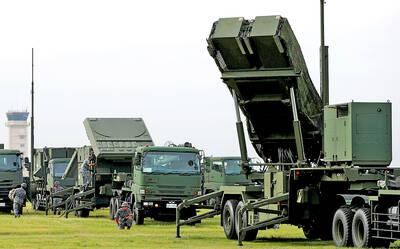Japan’s core consumer prices fell 1.2 percent last month from a year earlier, marking a full year of grinding deflation and suggesting the Bank of Japan (BOJ) may need to ease monetary policy again in the next few months.
The so-called core-core consumer price index, Japan’s narrowest measure of consumer inflation that strips out both energy and volatile food costs, also logged a near-record annual fall as weak household demand forced companies to cut prices.
Many analysts expect the debt-laden government, worried about an economic downturn ahead of an upper house election likely in July, to prod the central bank into easing policy further.
Japanese Finance Minister Naoto Kan hinted as much by saying more efforts are needed to stop price declines.
The 1.2 percent fall in the core consumer price index, which includes oil products but excludes volatile food costs, matched a median market forecast. The pace of drop slowed slightly from January, but retailers remain under pressure to cut prices while coping with a profit squeeze to woo consumers who are tightening belts amid falling wages.
The core-core inflation index, similar to the core index used in the US, fell 1.1 percent from a year earlier, after record falls of 1.2 percent in January and December.
“The pace of decline in prices is slowing somewhat, but prices are still falling,” Kan told reporters after the data. “More efforts will be needed in order to escape deflation.”
Kan also said he wanted to push forward debate on how to use ¥1 trillion (US$10.78 billion) in reserves in the budget for the fiscal year from April 1, which the parliament passed a day earlier.
Kan stopped short of saying the government plans to launch extra stimulus, because Japan’s outstanding debt is almost twice the size of its GDP, leaving little room for fiscal spending.
Ratings agencies have threatened Japan with a downgrade if it doesn’t show more fiscal discipline, so the government has been leaning on the BOJ to support the economy.
The BOJ loosened monetary policy earlier this month by doubling to ¥20 trillion the amount of loans it offers commercial banks for three months at 0.1 percent, which is the benchmark rate. It is likely introduce a similar six-month funding scheme in the next few months to lower term rates further, economists say.
The central bank’s policy board next meets on April 6 and 7, and then on April 30, when it reviews policy and its economic and price forecasts in a twice-yearly report.

MILITARY BOOST: The procurement was planned after Washington recommended that Taiwan increase its stock of air defense missiles, a defense official said yesterday Taiwan is planning to order an additional four PAC-3 MSE systems and up to 500 missiles in response to an increasing number of missile sites on China’s east coast, a defense official said yesterday. The official, who spoke on condition of anonymity, said that the proposed order would be placed using the defense procurement special budget, adding that about NT$1 trillion (US$32,88 billion) has been allocated for the budget. The proposed acquisition would include launchers, missiles, and a lower tier air and missile defense radar system, they said The procurement was planned after the US military recommended that Taiwan increase

POLITICAL AGENDA: Beijing’s cross-strait Mid-Autumn Festival events are part of a ‘cultural united front’ aimed at promoting unification with Taiwan, academics said Local authorities in China have been inviting Taiwanese to participate in cross-strait Mid-Autumn Festival celebrations centered around ideals of “family and nation,” a move Taiwanese academics said politicizes the holiday to promote the idea of “one family” across the Taiwan Strait. Sources said that China’s Fujian Provincial Government is organizing about 20 cross-strait-themed events in cities including Quanzhou, Nanping, Sanming and Zhangzhou. In Zhangzhou, a festival scheduled for Wednesday is to showcase Minnan-language songs and budaixi (布袋戲) glove puppetry to highlight cultural similarities between Taiwan and the region. Elsewhere, Jiangsu Province is hosting more than 10 similar celebrations in Taizhou, Changzhou, Suzhou,

TWO HEAVYWEIGHTS: Trump and Xi respect each other, are in a unique position to do something great, and they want to do that together, the US envoy to China said The administration of US President Donald Trump has told Chinese President Xi Jinping (習近平) “we don’t want any coercion, but we want [the Taiwan dispute] resolved peacefully,” US ambassador to China David Perdue said in a TV interview on Thursday. Trump “has said very clearly, we are not changing the ‘one China’ policy, we are going to adhere to the Taiwan Relations Act, the three communiques and the ‘six assurances’ that were done under [former US president Ronald] Reagan,” Perdue told Joe Kernen, cohost of CNBC’s Squawk Box. The act, the Three Joint Communiques and the “six assurances” are guidelines for Washington

DEEPENING TIES: The two are boosting cooperation in response to China’s coercive actions and have signed MOUs on search-and-rescue and anti-smuggling efforts Taiwan and Japan are moving to normalize joint coast guard training and considering the inclusion of other allies, the Japanese Yomiuri Shimbun reported yesterday. Both nations’ coast guards in June sent vessels to the seas south of the Sakishima Islands to conduct joint training, the report said, adding that it was the second joint maritime training exercise since the nations severed formal diplomatic ties in September 1972. Japan dispatched the Nagoya Coast Guard’s Mizuho, a 134m, 6,000-tonne patrol vessel which can carry a helicopter, while the Coast Guard Administration (CGA) sent the 126m, 4,000-tonne Yunlin, one of its largest vessels, the report